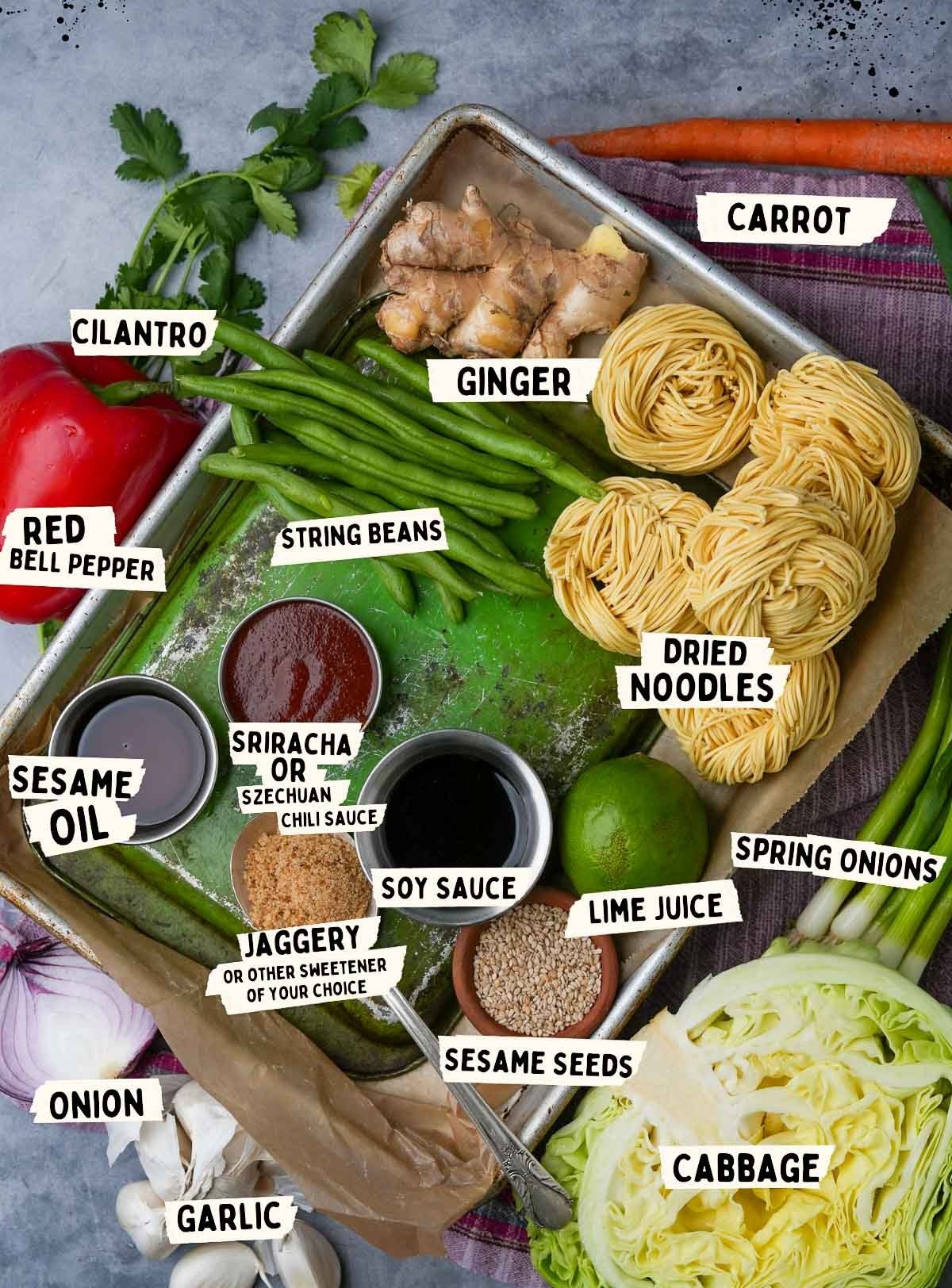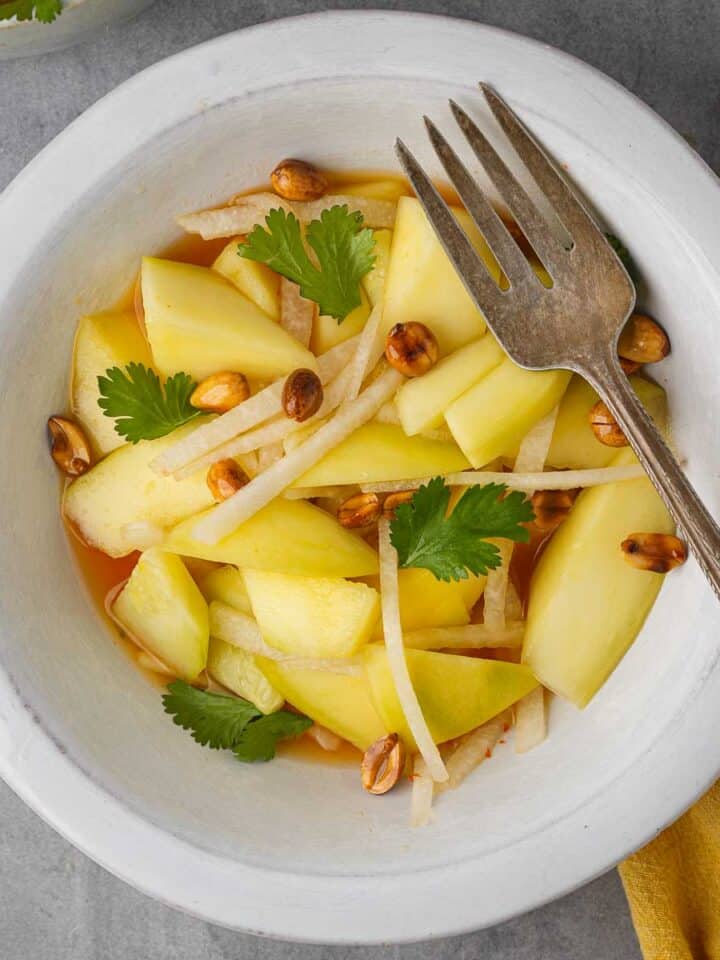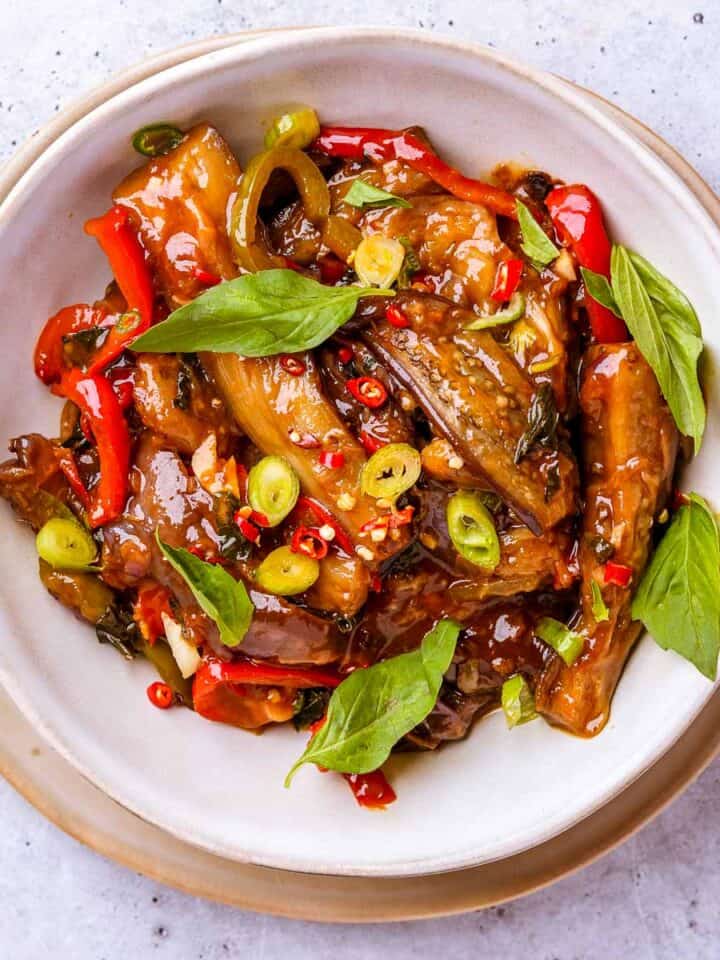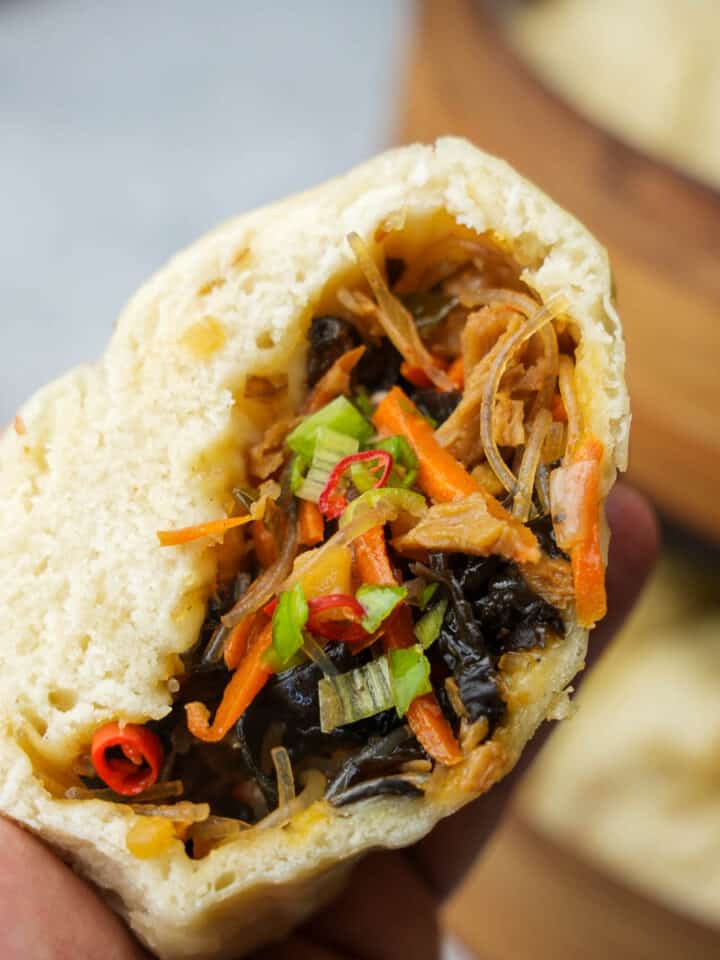*This post may contain affiliate links. Read more »
I know this is crazy, but after spending over 20 years regularly visiting India, it wasn’t until a few years ago that I ever got around to trying Vegan Hakka Noodles in Sri Mayapur Dhama in West Bengal. I was already hooked on Indo-Chinese bangers like gobi Manchurian, but I guess I wasn’t ready for the sweet spicy noodley-goodness that Hakka noodles were about to blow me away with. So, naturally, I have spent YEARS perfecting it as a fast vegan meal, that my whole fam loves.


Enter your email & I'll send it to your inbox. Plus, get great new recipes from me every week!
By submitting this form, you consent to receive emails from Cinnamon Snail.
Jump to:
🥰Why you'll adore this hakka noodle recipe
✊ Vegan AF: Just like all of my vegan Indian recipes, these noods don’t cause any suffering to animals, and have a much lower carbon footprint than non-veg versions.
🌡️ Temp Mastery: The use of sesame oil isn't just for its nutty aroma; it also has a high smoke point, making it ideal for stir-frying at high temperatures without breaking down, keeping your veggies vibrant and crunchy. Remember though, that this is India's take on Chinese cuisine, so other oils are OK to substitute with if you want.
✅ Tested and Approved Worldwide: A massive network of recipe testers across the globe test all of my vegan recipes before I share them on the blog. These Hakka Noodles have been given the thumbs up by a team of over 400 cooks!
Why are these called Hakka Noodles anyway?
Hakka noodles are named after the Hakka people, originally from the Hakka-speaking provinces of Guangdong, Fujian, Jiangxi, Guangxi, Sichuan, Hunan, and Zhejiang in China. Unlike some other Indo-Chinese dishes, Hakka Noodles were first made by the Chinese community that lived in Kolkata, where the air quality of a single day of breathing is now equivalent to smoking several packs of cigarettes. This community adapted Chinese seasoning and cooking techniques to Indian tastes through the use of spices and ingredients such as cumin, coriander seeds, and turmeric.
Now Hakka Noodles are often made as India’s answer to instant ramen. But recipes like the one you are looking at step it up with scratch-made seasoning and fresh veggies. Fire up your stove, and let’s get those noodles bouncing around in your wok!
Wait, what even is Indo-Chinese cooking?
In India, there are three main styles of cuisine you see everywhere: North Indian, South Indian, and what they call “Chinese food” which is about as Chinese as American bowling alley nachos with vegan nacho cheese are “Mexican”.
India famously makes everything taste kinda, well, Indian. I remember being in Mysore with my family, who was craving on-Indian food and they tried to order “Srinich Lasangene” from an Indian “Italian” menu. Suffice to say there was turmeric and hing in that, uh, Lasangene.
Anyway, India has sorta reinvented and reimagined Chinese dishes with Indian spices and flavors, and when it’s made well, it’s friggin’ awesome. When it’s not made that well, it usually contains ketchup and other such crap.
🌶️ Ingredients for this veg hakka noodles recipe

The Noodles Themselves
Pssst. Come a lil’ closer, my noodle loving buddy. This is the secret: there is no exact pasta called “Hakka noodles.” While some non-veg eaters make it with egg noodles, instant ramen noodles (don't hate on them- they also make killer curry laksa), Shanghai-style noodles (like I use to make mie goreng, and even angel hair spaghetti, like I use for making Khao Suey work). Just about any noodles will work except thicker noodles such as udon, which are better off reserved for projects like bami goreng. You can make this recipe gluten-free by using rice noodles.
Sesame Oil
This oil, known as gingelly in India, is used in many styles of cuisine throughout Asia for its nutty, rich flavor and high smoke point, making it suitable for frying without breaking down. Sesame oil is also great for grilling, which you can see in full force in my Korean BBQ sauce recipe, or raw, which you can check out in my Goma Dressing recipe. If you don’t have sesame oil, or don’t like it, you can make Hakka noodles with any other high-heat oil such as peanut oil, canola oil, sunflower oil, or vegetable oil.
Sweetener
Regular ol’ cane sugar, jaggery, coconut, palm, or brown sugar can all be used in this recipe to balance the acidity of the lime and the heat of the other spices. Palm sugar is my fave, and I keep it on hand to make the filling for Malaysian Klepon, the caramel sauce for Filipino suman, and the wonderful sweet spicy sauce for Indonesian Tahu Goreng.
Tamari
Tamari is a soy sauce that is prepared without wheat. This makes it suitable in gluten-free recipes, which is why it’s normally the main soy sauce I keep on hand, since I often find myself cooking for folks with wheat allergies. If that’s not a concern for you, shoyu, soy sauce, or coconut aminos are all fine to use.
Chili Sauce
While Szechuan chili garlic sauce is often used for making Hakka noodles, I like the flavor and natural ingredients in Sriracha more, and for folks in America, it’s often easier to come by. You can also make it from scratch really easily following my sriracha recipe!
I love using it to make my Thai basil eggplant, the spicy mayo for my vegan banh mi, and vegan pad see ew. For sure, you can use a different hot sauce such as my homemade sambal oelek, but ideally DO NOT use something like Franks for making hakka noodles (even though that stuff is pretty great, and is essential for making vegan buffalo wings with).
*See the recipe card at the bottom of the page for exact quantities, nutritional info, and detailed cooking directions.
🤯Variations
Thai Hakka Noodles:
Add a spoonful of red curry paste or tom yum paste to the sautéing onions. Garnish the dish with nam prik pao (Thai chili jam) or nam jim jaew (Thailand's raw sambal) and garnish with small fresh Thai basil leaves. Trust me, this variation is seriously banging!
Indonesian Hakka Noodles:
Use some bumbu Bali and lime leaves in the oil when you are frying the veggies. Serve these noodles alongside sambal goreng tempeh, topped with sambal matah or sambal dabu dabu, and be prepared for some legendary, crave-able spice in your life!
📖 How to make Indo Chinese Hakka Noodles
Nail these noods on your first shot by following these step-by-step photos with helpful tips. Or scroll down to the bottom of this page for the easy-to-print recipe card.

Step One
Noodle Niceness:
Begin by preparing the noodles as per the directions on their packaging. Aim for a firm, just al dente texture (keeping in mind that the noodles will cook a little longer when stir-fried). After boiling, promptly cool the cooked noodles under cold water, then set aside to drain thoroughly.
✅ If it will be more than ten minutes before you are ready to use the noodles, massage a tiny amount of sesame oil into the drained, cooled, boiled noodles to prevent sticking.

Step Two
Start Sizzlin’
Warm the sesame oil in a broad wok or Dutch oven over a lively medium-high heat. After 90 seconds, when the oil is hot, add the thinly sliced onions and sauté for 3-4 minutes until they are tender and translucent.

Step Three
Aromatic Magic:
Toss in the garlic and ginger, and stir fry for a minute or two until their aroma fills the air. Then follow with the scallions, giving them a quick stir.

Step Four
Veggie Toss-Up:
Add the green beans, cabbage, bell peppers, and shredded or julienne-cut carrots to the hot pan. Stir-fry these for a few minutes to soften them a little without turning them into terrible, sad mush…

Step Five
Send Noods:
Return the drained noodles to your wok. Drizzle over the lime juice, chosen sweetener, tamari, and sriracha (or a different red chili sauce of your choosing). Using tongs, toss all ingredients well to coat the noodles and veggies in the sauce and get the noodles nice and hot.

Step Six
Garnish & Serve:
Dish up the hot noodles adorned with extra sliced spring onions, fresh cilantro leaves, and a sprinkle of toasted sesame seeds.
💡Serving Ideas
Because Hakka Noodles are on the borderline of Indian and other Southeast Asian cooking styles, it’s kinda remarkable the diverse array of dishes that go great with it.
If you want to go in a more Indian direction with it, serve ‘em up with a veggie-centered dish to balance their carbs, such as bhindi dry, saag aloo, aviyal, or turai ki sabji. Some condiments to kick it up? Get messing with some cilantro chutney, amla pickle, gajar ka achar, or tamarind chutney if you want a sweeter sauce.
Wanna go in a more Southeast Asian vibe what do you pair the noodles with? I love sambal goreng kentang, which are spicy Indonesian potatoes. Filipino dishes like sitaw, ginataang kalabasa, or the smokey eggplant dish ensaladang talong all go extra-deluxe-amazing with these vegetarian Hakka noodles.
👉Top tips
- Dialed-In Oil Heat: Choose an oil with a high smoke point, like sesame or avocado oil, for stir-frying. Heat the oil until it's shimmering but definitely not smoking before adding ingredients to the pan. This will prevent the veggies from becoming soggy from slowly steaming as they cook, as they might with a lower temperature.
- Noodle Mastery: When you are initially joining them in water, cook your noodles just until they're al dente—tender, but still a wee bit firm to the bite. This is crucial because it prevents them from absorbing too much sauce and becoming mushy. If you are making this recipe gluten-free by using rice noodles, simply soak them in warm water for about 15 minutes instead of boiling them. That way, they will not fall apart when stir-fried.
- High and Fast Cooking: Stir-fry your vegetables on medium-high heat but only briefly to keep them from becoming a lifeless mess. This high-heat, quick-cooking method locks in flavors and textures, making your Hakka noodles restaurant-quality.
- You Don't Eat Enough Acid: Want more tanginess? A little white vinegar, rice vinegar, or an extra squeeze of lime juice is all you need to balance the sweetness of these noodles, if that's your preference.
- Want to make vegan chicken hakka noodles? It's easy! Just sauté hand-torn pieces of my vegan chicken in a wok or skillet until lightly golden, and stir them into the noodles towards the end.
🤷♀️ Recipe FAQs
Hakka noodles are traditionally made from refined wheat flour, but you can also find whole wheat varieties. Ching's Hakka Noodles are popular and easily available at Indian grocery stores or online. If you can't find pasta which is labeled as “Hakka noodles”, instant ramen, angel hair pasta, Shanghai noodles, or rice noodles (if you avoid gluten) will all work great in this recipe.
While both dishes involve stir-fried noodles, Hakka noodles are known for their distinctive Indo-Chinese flavors and are typically tossed on a high flame, which gives them a unique taste and texture compared to the various regional versions of chow mein found around the world.
To prevent Hakka noodles from sticking, rinse them under cold water immediately after cooking. This stops the cooking process and washes away excess starch. Massaging them with a bit of sesame oil is a great plan if they are going to be sitting around for more than a few minutes before getting stir-fried.
Absolutely! To add heat to this Hakka noodles recipe, incorporate chili oil, shatta sauce, crushed red pepper flakes, or minced fresh bird’s eye chilies, or hari mirch green chilies (available at any decent Indian grocery store) into the recipe.
🧊 Refrigeration
To keep Vegan Hakka Noodles fresh in the refrigerator, allow the noodles to cool to room temperature after cooking. Transfer them to an airtight container and store them in the fridge for up to four days. When ready to reheat, choose either the stovetop or microwave method below.
❄️ Freezing
Noodles don’t freeze and thaw well. Plus, thawing them would probably take just as much time as making them fresh. So, let's back away from the darned freezer now, and forget we ever needed to have this little discussion, ok?
🔥 Stovetop Reheating
For stovetop reheating, transfer the noodles to a skillet or wok. Add a small splash of water or a tiny amount of extra sesame oil to prevent them from drying out. Reheat them over medium heat, stirring frequently until they are heated thoroughly.
⚡️ Microwave Reheating
To reheat the noodles in the microwave, place them in a microwave-safe dish and cover with a ceramic plate or a microwave-safe lid. Sprinkle a little water over the noodles to keep them moist. Heat on high for one to two minutes, stirring halfway through to ensure even heating. This is a quick and effective method to warm up the noodles when you're in a hurry.
✌️My faves to serve with these veg hakka noodles:

Vegan Hakka Noodles
Equipment
Ingredients
- 200 grams hakka noodles
- 2 tablespoons sesame oil
- 1 small onion thinly sliced
- 1 tablespoon garlic minced
- 1 teaspoon ginger grated
- 2 scallions cut into 2 cm. Sections
- 12 green beans cut into 2 cm. sections
- 1 cup cabbage chopped
- 1 red bell pepper thinly sliced, seeds and stem discarded
- 1 cup carrot julienne cut or shredded
- 1 tablespoon lime juice
- 2 tablespoons jaggery coconut sugar, palm sugar, or brown sugar
- 2 tablespoons tamari
- 2 tablespoons sriracha
To Garnish:
- Additional sriracha or Szechuan chili sauce
- Scallions thinly sliced
- Cilantro leaves
- Toasted sesame seeds
Instructions
- Begin by cooking the hakka noodles according to the package instructions until al dente. Once cooked, drain the noodles and rinse under cold water to stop the cooking process. Set aside to drain completely.
- Heat the sesame oil in a large wok or Dutch oven over medium-high heat. After 90 seconds, when the oil is hot, add the thinly sliced onion and sauté for 3-4 minutes until soft and translucent.
- Add the minced garlic, ginger, and scallions to the pan and cook for another minute until aromatic.
- Stir in the chopped green beans, cabbage, thinly sliced red bell pepper, and julienned carrots. Continue to stir-fry the mixture, tossing frequently for 3-5 minutes, until the vegetables are just tender but still retain some crunch.
- Return the drained noodles to the wok. Pour the lime juice, your choice of sugar, tamari, and sriracha sauce over the noodles. Toss everything together to ensure the noodles and vegetables are evenly coated with the sauce and heated through.
- Serve the noodles hot, garnished with additional sriracha, thinly sliced scallions, cilantro leaves, and a sprinkle of toasted sesame seeds.
Notes

Enter your email & I'll send it to your inbox. Plus, get great new recipes from me every week!
By submitting this form, you consent to receive emails from Cinnamon Snail.





Leave a Reply